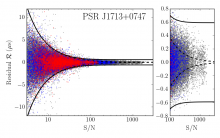
Abstract
Low-frequency gravitational-wave experiments require the highest timing precision from an array of the most stable millisecond pulsars. Several known sources of noise on short timescales in single radio pulsar observations are well described by a simple model of three components: template fitting from a finite signal-to-noise ratio, pulse phase/amplitude jitter from single-pulse stochasticity, and scintillation errors from short-timescale interstellar scattering variations. Currently template-fitting errors dominate, but as radio telescopes push toward higher signal-to-noise ratios, jitter becomes the next dominant term for most millisecond pulsars. Understanding the statistics of jitter becomes crucial for properly characterizing arrival time uncertainties. We characterize the radio frequency dependence of jitter using data on 48 pulsars in the North American Nanohertz Observatory for Gravitational Waves timing program. We detect significant jitter in 43 of the pulsars and test several functional forms for its frequency dependence; we find significant frequency dependence for 30 pulsars. We find moderate correlations of rms jitter with pulse width (R = 0.62) and number of profile components (R = 0.40) the single-pulse rms jitter is typically ≈1% of pulse phase. The average frequency dependence for all pulsars using a power-law model has index -0.42. We investigate the jitter variations for the interpulse of PSR B1937+21 and find no significant deviations from the main pulse rms jitter. We also test the time variation of jitter in two pulsars and find that systematics likely bias the results for high-precision pulsars. Pulsar timing array analyses must properly model jitter as a significant component of the noise within the detector.